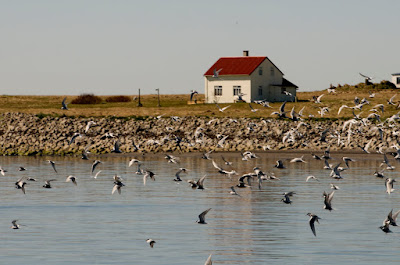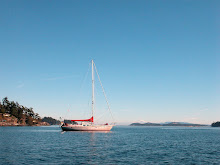Under staysail alone, we made our way back to Hesteyri. David binoced the settlement looking for evidence of a cafe but all he saw was a large group of tourists walking along the beach and some normal looking houses. After a scenic detour to the head of the fjord we turned around and anchored in front of a small jetty.
On shore Krystina explained our mission to a young American couple who were waiting for the ferry. They informed us that David's guide book was correct and that we could find the cafe in the house with the green roof. We thanked them for the information and took a walk along the beach before checking out the cafe.
There were people coming in and out of the building as we approached but we were still surprised to find a normal looking cafe in such a remote location. We ordered coffee and a plate of pancakes to share before finding a table by a window that looked out on Snow Dragon. The people running the cafe were very friendly and told us that the house used to belong to the town doctor before the community was abandoned in 1952. We also learned that the nearby whaling station was Norwegain and later used by the Icelanders to process herring.
With 20 knots of easterly wind and building, we left for Isafjordur with a double reefed main and staysail. Snow Dragon surfed at over 8 knots for nealry an hour. By the time we got out into the middle of Isafjardardjup, the wind dropped just in time for us to be able to sit out in the cockpit and enjoy our dinner with a comfortable motion. The wind continued and we managed to sail until a few minutes before dropping the anchor, needing the motor for the final positioning.
Tomorrow David heads back to England and we will turn our focus to getting Snow Dragon ready for Greenland. It has been a pleasure having David onboard and we look forward to him and Georgina - who was too busy to come this year - continuing their annual tradtion of visiting Snow Dragon in interesting locations.
For more photos please click on Coffee Album.



































